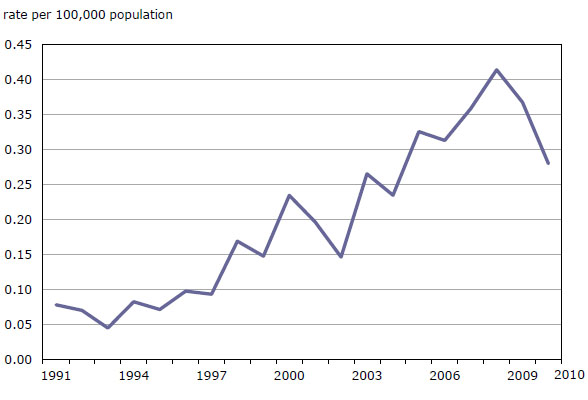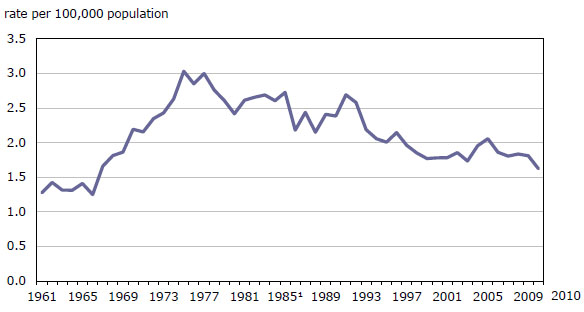but it very much is a problem for Canada.
In order to get the cocaine and other "hard" drugs to market in Canada from other sources via the US, would-be distributors here have to have something to trade. The loonie is not in high demand. Pot is, in the US.
So pot is grown in Canada for export to the US. And the organized crime element that grows most of that pot is just like organized crime everywhere: vicious and violent.
The stakes aren't as high and the society and economy aren't as chaotic in Canada as in Mexico, so we don't have all-out war. But we have a significant problem.
http://www.statcan.gc.ca/pub/85-002-x/2011001/article/11561-eng.htmGang-related homicides, Canada, 1991 to 2010

Overall, organized crime and/or gang activity is related to fewer than 1 in 5 homicides in Canada each year. According to the Criminal Intelligence Service Canada (CISC), extreme violence is generally counter-productive for organized crime groups as it both distracts from profit-oriented activities and attracts the attention of law enforcement (CISC 2010). In the Homicide Survey, incidents are classified as �gang-related� when police believe the homicide occurred as a consequence of activities involving an organized crime group or street gang. Homicides of innocent bystanders who are killed as a result of gang-related activity are also considered to be gang-related.
In 2010, 94 homicides were considered by police to be gang-related,
accounting for 17% of all homicides reported to police. This represented a 25% drop and the second annual decline, following a high in 2008 when 138 homicides were reported by police as gang-related (Table 6). Despite these recent declines, the rate of gang-related homicide has generally been increasing in all provinces since the Homicide Survey began recording this information in 1991 (Chart 8). The only exception is in Quebec, where gang-related homicide was at its highest in 2000.
... The characteristics of gang-related homicides tend to differ from other types of homicides in a number of ways. Compared to homicides that were not gang-related, gang-related homicides in 2010 were more likely to have been committed by more than one accused person (66% versus 13%), to have involved the use of firearms (76% versus 18%) and to have been related to the illegal drug trade (such as trafficking or settling of drug-related accounts) (62% versus 9%). The most common drugs identified in gang-related homicides involving drugs were cocaine (51%) and cannabis (31%).
Victims of gang-related homicides, like persons accused in these incidents, are usually male, relatively young and are often involved in criminal activities themselves. More specifically, in 2010, close to 93% of gang-related homicides involved a male victim, compared to 66% of other homicide victims. Victims of gang-related homicides were also younger on average than other homicide victims (31 and 36 years, respectively), though not as young as persons accused in gang-related incidents (24 years on average).
Close to 7 in 10 victims in gang-related homicides (68%) had a criminal record, lower than the proportion among persons accused in gang-related incidents (88%). Victims of these homicides were also more likely to be involved in criminal activities themselves. Police respondents recorded illegal activities as the main source of �employment� for 7 in 10 victims of gang-related homicide (71%), six times higher than for other homicide victims (12%). The most common motive3 recorded by police for gang-related homicide was the settling of accounts (61%).
Gang-related homicides in Canada have notable non-gang-involved victims: mistaken identity, bystanders including children, and simply terrorizing of neighbourhoods by random shootings are seen.
Now, consider the effect on overall homicide numbers and rates:
Following a decade of relative stability, homicides decreased substantially in 2010. There were 554 police-reported homicides in 2010, 56 fewer than the year before ... . The 2010 homicide rate fell to 1.62 per 100,000 population, its lowest level since 1966 ... .
Canada's homicide rate is ridiculously low already (with the sharp drop in 2010): 1.62/100,000; consider the 20-year decline, and whether the decline observed in the US has been
proportionately equivalent, even not considering the high starting point and thus more room for improvement in the US:
Homicides, Canada, 1961 to 2010

Were it not for the extent to which gang-related homicides have driven that figure (see the chart at the beginning), that rate would have been more like 1.4/100,000.
It might be interesting to see the US breakdown.
If the presence of guns instantly kicks off an orgy of shootings, beheadings, and unspeakable acts involving 55 gallon drums then why isn't Canada in flames as well?Well, if pigs could fly, you'd have yourself a question there.
As for Canada, the obvious fact that the numbers of firearms and particularly handguns in criminal hands just doesn't begin to approach the situation in the US or Mexico just might be a contributing factor, but there are obviously a load of others, including, as I mentioned, a strongly functioning civil society with all its defences against lawlessness.